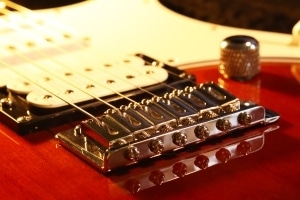
Do you love the twangy sound of your stock Strat tremolo but wish it would perform better and stay in tune? You don’t have to replace it and lose your coveted tone. In this article, I’ll share my awesome tips and tricks that you can use for your Stratocaster tremolo setup.
Keep on reading to check out some of the available options that can make your whammy bar sing like a canary and keep your tuning stable!
If you just want the Strat tremolo setup tips, then scroll through the next two sections.
What Is A Tremolo?

For those of you that do not know, a guitar tremolo is a bridge on a guitar that’s made to move up and down to allow you to raise and lower the pitch of the note(s) you are playing. It is also called a “Whammy Bridge,” named after the whammy bar that allows you to operate the tremolo.
The featured image at the top of this article shows you what a Fender whammy bar looks like.
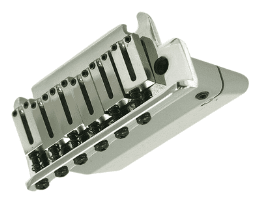
Strictly speaking, the term “tremolo” is misused when applied to guitar bridges. It should be called vibrato instead.
Tremolo means to vary the amplitude (loudness) of a sound. Vibrato means to vary the pitch of a sound, which is what guitar “tremolos” do.
Interestingly enough, I often hear musicians refer to it as a tremolo with a vibrato bar.
At this point, I’m not about to start calling it a vibrato bridge, and neither should you unless you really want to.
Why Use A Tremolo?
A tremolo (or tremolo bridge) is used to vary the pitch of the notes you play. The advantage of using a tremolo over bending the strings with your fingers is that you can actually lower the pitch of a note below what is even possible to play on a guitar or raise it higher than you would be able to bend a string with your fingers comfortably.
Using a whammy bar is not really a substitution for bending strings with your fingers. They both have their own distinct sound, which varies from one player to the next. For example, just by hearing a few notes, you know it’s B.B.King without ever hearing the song before.
The way you use a whammy bar can determine the type of tremolo you need and how it needs to be set up.
Making Your Strat Tremolo Perform Better
There are several ways to make your strat or any other guitar’s tremolo perform better and stay in tune. Here are some of the most common things I’ve seen players do.
I use some of these methods on occasion, but I have to say I really prefer the sound of Strat with a vintage tremolo bridge and no mods.
Please do not make any modifications to our guitar on your own unless you know what you’re doing. You could permanently damage your guitar, or the guitar may not play and sound right. Instead, take your guitar to an experienced repair shop and have them make the modifications.
Also, be aware that modifications can permanently change the sound of your guitar for better or worse, even if they are done professionally.
Lubricant
There are a variety of lubricants that you can use on your guitar to keep it in tune. Lubricant is typically applied to the tremolo bridge pivot points and bridge saddles, non-locking nuts, and string trees/retainers.
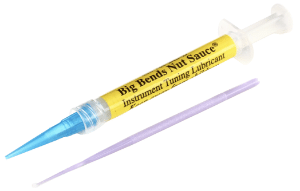
If you have a Strat with a typical whammy bar setup, then using a good lubricant is one of the easiest and most effective things you can do to help keep it in tune.
This is probably all you need if you are a player that hits the whammy bar now and again for effect.
I have used a lot of lubricants, and there are many excellent options to choose from, but I prefer “Big Bends Nut Sauce.”
It comes in an easy-to-apply applicator with a micro-brush for hard-to-reach places. In addition, nut Sauce is viscous, so it stays where you put it.
String Sleeves
If you use thin gauge strings and whammy a lot with a standard Strat tremolo bridge, then you might be breaking your high-E and B strings. So the first thing to do is to check to ensure that you do not have any burs or rough edges in your bridge saddle string slots.
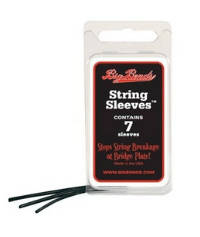
If your tremolo bridge looks okay, you can try using a string sleeve on the appropriate string(s). Many aggressive Strat players, including guitar-genius Jeff Beck, have used string sleeves to solve their string breakage problems at one time or another.
For more info about Jeff, see Jeff Beck’s Guitar Style – The Guitar Player’s Guitarist!
String sleeves not only help prevent string breakage, but they can help keep your guitar in tune by preventing a string from moving from side to side on an ungrooved bridge saddle when you slacken it using the whammy bar.
Be aware that they can dampen your tone, sustain, and harmonics, so only use them if necessary.
The easiest thing to do is buy a set of Big Bends String Sleeves or another brand of your choice.
You can make a string sleeve by simply stripping a piece of plastic insulation off a small diameter electrical wire or using an appropriate size piece of heat-shrink tubing (don’t shrink it around the string).
Slide the sleeve over the string where it makes contact with the bridge saddle, and you’re good to go.
Graphite And Synthetic Self-Lubricating Guitar Parts
Using graphite and graphite replacement parts for your guitar is a great way to reduce string friction. Many guitar companies offer graphite parts as an option for tremolo guitars.
There are many places to purchase graphite parts. Graph Tech is an excellent company that makes high-quality products.
The Pencil Trick

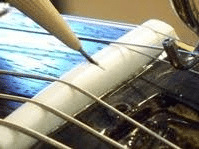
As you lower and raise notes with the bar, the strings can “slide” along the nut in both directions. However, if you use a regular (bone or synthetic) nut, the strings may not slide back to their original position in the nut slots.
Many Strat players use the “pencil trick” to lubricate a standard nut. They use a sharpened pencil to “color in” the nut slots, and the graphite provides enough lubrication to improve tuning stability during mild to moderate whammy bar usage.
Graphite Nuts
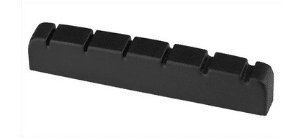
Graphite nuts are an easy way to reduce nut friction when using a whammy bar. They work better than the pencil trick, and you don’t have to keep coloring in the nut slots every so often.
Some guitars have a pre-installed graphite nut, but a regular nut can be swapped out for a third-party graphite nut.
When replacing nuts, it’s important to get the proper size, shape, and configuration (string spacing, etc.). In addition, the nut slots have to be adjusted to match the fingerboard radius, etc.
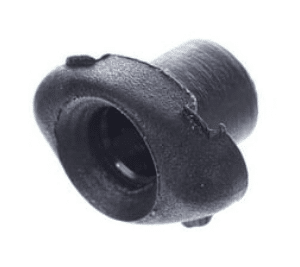
String Tree
Graphite String Trees
If your strat has string trees, you can replace them with graphite string trees, which will also help reduce string friction when using your whammy bar.
String trees are easier to replace than a nut.
If you have staggered locking tuning machines, then you don’t really need string trees.
Graphite Bridge Saddles
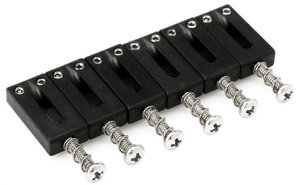
Finally, you can also replace your Strat bridge saddles with graphite counterparts. Like the nut, changing your bridge saddles can alter your guitar’s sound considerably, but it is very easy to replace your original saddles if you don’t like the sound.
I have tried graphite saddles on a few of my Strats, and I have to say that I much prefer the sound of the original Fender saddles. It’s just a matter of taste, so don’t be afraid to give it a try.
You don’t necessarily have to replace all your bridge saddles. You can replace just the top three or the bottom three or just the saddle of a single string that won’t stay in tune or keeps breaking when using the whammy bar.
Roller Nuts
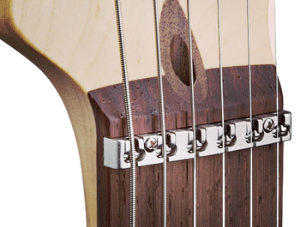
Roller nuts are another way to decrease string friction at the nut. Fender installs its LSR Roller Nut on select guitars, but they can also be installed as an aftermarket nut replacement.
Each nut slot has two little ball bearings that the string glides over as you use the whammy bar to reduce friction and help keep the guitar in tune.
I have several Strats that came with LSR roller nuts, and I have installed them on guitars that I have built. They work well and sound good but, to me, nothing beats the classic sound of a Strat with a bone nut.
Wilkinson Nuts And Bridges
Trevor Wilkinson, a guitar player and guitar parts designer, extensively studied why whammy bar use can put a guitar out of tune. As a result, he came up with several nut and bridge designs to address the problem.
Many of his products are still manufactured through companies in Korea and China that have licensing rights, like Gotoh and Sung. In addition, Stewart Macdonald sells several Wilkinson products.
Wilkinson Nuts
Several types of Wilkinson nuts claimed to help tremolo guitars stay in tune while improving the instrument’s tone and harmonics.
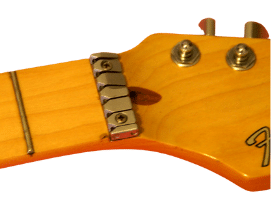
Fender started incorporating Wilkinson nuts on their Strat Plus guitars in the 1980s but then began installing their own LSR roller nut instead.
Jeff Beck still uses the “split design” Wilkinson nut on his Masterbuilt Strats. The split design was thought to help decrease friction on the bottom three strings.
They are no longer available to purchase new, but apparently, the Fender Custom Shop has a stash reversed for Jeff.
If Jeff likes that nut, then I’m all in!
I was lucky enough to buy a Todd Krause Masterbuilt Jeff Beck Signature Strat with a split Wilkinson nut, which works and sounds awesome!
Wilkinson Bridges
Wilkinson also designed a series of tremolo bridges that enhance tuning stability and improve string sustain.
Here is a great video from StewMac where Dan Erlewine interviews the legendary Trevor Wilkinson about the design and function of the VS-100N Tremolo. Check it out!
String Locks
String locks keep all the strings on your guitar from moving at the headstock-end when you use the whammy bar. They can lock the stings at the nut or behind the nut.
They are for players that make aggressive use of a whammy bar
Locking Nuts
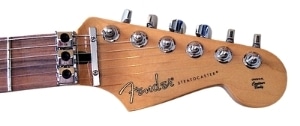
String Retainer (Fig 1)
Locking nuts replace a traditional nut and are typically installed at the factory, but they can also be installed as after-market items.
They are mostly found on guitars that have a locking tremolo bridge. A double-locking tremolo system (locking bridge plus locking nut) is typically used by whammy-intensive players.
See the section on “Whammy Dive Bomber” below for more info.

“Behind-The-Nut” Lock –>
Use Locking Tuners And Lose The String Lock! (Fig 2)
Behind-The-Nut String Locks
Behind-the-nut string locks do not work as efficiently as locking nuts, but they are a popular after-market option because they are easier to install than a locking nut.
Locking Tuners

Locking tuners work well for players that Whammy a lot (whammy bar “showcasers”) but are not constantly dive-bombing.
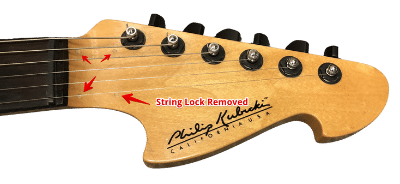
Locking Tuners With A Graphite Nut
When using a whammy bar, the best way to use locking tuners is in combination with a graphite nut.
The graphite nut plus locking tuner combo makes it much easier and quicker to change strings.
A string tree or retainer is unnecessary if the locking tuners are “height-staggered” (highest on low-E to lowest on high-E).
Figure 3 shows a guitar that I worked on. It had a Kahler Tremolo with a plastic nut, a behind-the-nut string lock, and vintage-type tuners (similar to Figure 2 but with a plastic nut). Unfortunately, the Kahler Tremolo was added after the guitar was bought, so it didn’t have a locking nut.
I changed the nut to graphite, removed the string lock, and changed the tuners to Sperzel locking tuners. You can see the plugged holes where the string lock was (marked with red arrows in Figure 3).
After adjusting the Kahler tremolo to accommodate the new setup, the guitar played great and stayed in tune pretty well with aggressive whammy bar use, but nothing works as well as a locking nut and a string retainer (see Figure 1).
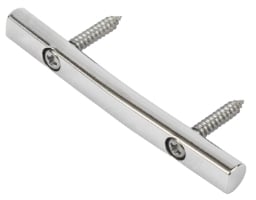
String Retainers
String retainers are used on guitars that come with a locking tremolo and a locking nut. They sit just behind the locking nut (see Figure 1).
Some guitars without locking nuts also come with string retainers.
String retainers help keep downward pressure on the strings to help improve tuning stability. On guitars without locking nuts, string retainers also help keep strings wound properly on the tuning machines when they are slackened with the whammy bar.
Tremolo Bridge Setups
There are three ways to set up a tremolo. Each way has its pros and cons.
Guitarists adjust their tremolo to accommodate their playing style.
Fixed Bridge

At Woodstock
The tremolo sits flush against the guitar body with a fixed bridge, and notes can only be lowered, not raised.
The advantage of using a fixed bridge is that it gives you better tuning stability if you have a non-locking tremolo.
This is how most of the Strats with vintage tremolos are set up at the factory, whereas the guitars with 2-point bridges are usually set up to float in both directions (up and down).
Jimi Hendrix is an example of a player that used a fixed bridge, and he used it to create some of the most innovative sounds of his time!
Floating Bridge

The bridge is set up so that it “floats,” which means it is adjusted so that the back part of the bridge does not sit flush against the guitar body. This allows the bridge to be moved in both directions (up and down).
Floating bridges are used by guitarists to raise and lower the pitch of notes.
A floating bridge allows you to be more expressive as a player, but it is harder to keep in tune than a fixed bridge unless you use a double-locking system.
Steve Vai is a great example of a player that uses a double-locking floating bridge.
Blocked Bridge

A blocked bridge is a bit of a special situation, where a guitarist uses a block of wood to completely immobilize a tremolo bridge so that it can’t move in either direction (up or down).
So, what’s the point of blocking a tremolo bridge if it can’t be used? Why not just configure it to be a fixed bridge and unscrew the tremolo bar?
How about buying a hard-tail Strat instead and eliminate the tremolo?
Many players believe that the tremolo block and springs add a special quality to the sound of a strat, especially when it is completely immobilized.

Compare the sound of a tremolo Strat to a hard-tail Strat. If you listen carefully, I think you will notice the difference.
One guitar virtuoso that is famous for blocking his tremolo is Eric Clapton. Eric’s Signature Stratocasters all come with a pre-blocked tremolo.
To make the tremolo work, you would have to unscrew the backplate and remove the block of wood between the tremolo block and the guitar body, although I wouldn’t suggest it if you want to keep the “Clapton sound.”
What Kind Of A Player Are You?
Different players will require different types of tremolos or tremolo setups to make their guitar play in tune. Here are five “Strat Player Categories.” Do you fit into one of them? ?
The “Strictly Rhythm” Player

Rhythm Powerhouse!
You love playing rock and roll rhythm guitar. You learned every power chord and even came up with a few of your own.
Your favorite player is someone like Malcolm Young. String bending and guitar soloing are not really part of what you like to do.
You’ve owned Strats, but any good electric will do.
If that sounds like you, then you are probably a “strictly rhythm” player.
If you have a guitar without a tremolo or it is “fixed,” and you never use it, then keeping it tune is Easy-Peasy! Your guitar just needs to be set up correctly and have a fresh set of properly strung and stretched-out strings.
“I Don’t Use A Whammy Bar” But “I Love A Strat”
You bought a Strat because you love how it looks and sounds, not because you need a whammy bar. You didn’t purchase a hard-tail Strat (no vibrato bridge, strings just go through the body like a Tele) because they a hard to find, or they don’t sound as good as a Strat with a tremolo bridge.
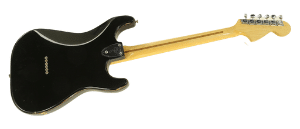
Go Thorough Back
Your whammy bar never gets screwed into the guitar, and the tremolo bridge sits flat against the body (non-floating). As a result, the bar stays in your guitar case, and you may have even lost it by now.
There’s not much you need to do to keep your guitar in tune other than routine adjustments and proper intonation.
If you do a lot of 1 -1 ½ step finger bends, then all you basically need to do to keep your guitar in tune is to lubricate the nut, assuming it’s bone or plastic.
The “Whammy Bar Wrangler”

This category probably describes most Strat players, especially the beginning guitarists.
You may have bought a Strat because it’s the guitar all or most of your favorite players use (like I did).
The whammy bar is something you enjoy using now and again to add a little spice to certain passages, but you don’t bend up or down too aggressively.
You probably leave it factory adjusted and think it works just fine.

A Strat with a vintage tremolo bridge will probably work great; you don’t need anything more sophisticated.
If you find yourself re-tuning your guitar after using the bar, you might not have wound your strings correctly onto the tuning machine posts. All you need are a few non-overlapping string turns.
If that doesn’t correct the problem, all you probably need is to lubricate your nut and possibly your bridge saddles.
PRS guitars have a simple but very tune-stable tremolo. For more info, see PRS SE Standard 24 Review – This Guitar Is Really Hot!
The “Whammy Bar Showcaser”

LSR Roller Nut
You love using the whammy bar pretty much every chance you get, but you don’t usually go totally overboard with it.
You have most likely set up your tremolo bridge to float so you can move the bar in both directions (up and down) and do really wide bends.

A Strat with a 2-point bridge and an LSR roller nut will probably work best for you.
Your guitar needs to be set up to reduce all string friction points

Roller Nut
Keep the 2-point knife-edge, bridge saddles, nut, and string trees all well lubricated, and change your strings often.
You can also consider graphite replacement parts if your tuning problem persists.
Using graphite bridge saddles with a graphite nut and height-staggered locking tuners is another option that works really well.
The “Whammy Bar Dive Bomber”
You love playing 80s-style arena rock, and you want to be a heavy metal monster! Guitar flash and whammy bar tricks are your forte. Your practice schedule revolves around speed and precision.
There’s no such thing as a great solo that doesn’t have at least one dive bomb. So one of the first things you learned to play was Eddie Van Halen’s “Eruption.”

Original Floyd Rose
You will most likely benefit from a full double-locking tremolo bridge setup, which Floyd Rose developed and patented.
Original Floyd Rose double-locking systems or licensed variants are commonly added to Strats as after-market items.
Installation requires special equipment and guitar building or repair expertise, so don’t attempt to install one if you’re not properly trained.
See the next section for more info on how a double-locking tremolo system works and what makes it different from a single-locking system.

Licensed Floyd Rose
Fender Stratocasters do come with a Floyd Rose or equivalent tremolo pre-installed.
Most players buy an Ibanez Strat-style guitar because they make high-quality double-locking models that fit a lower budget.
Double-locking tremolos are pretty easy to keep in tune and only require the occasional knife-edge and maybe bridge saddle lubrication. The biggest drawback with these systems is the time it takes to do a string change.
What Is A Locking Tremolo System?
Locking tremolo systems come in two basic types, single-locking and double-locking. In a double-locking system, both the nut and the tremolo bridge lock. A single-locking system has a locking nut and a non-locking tremolo bridge.
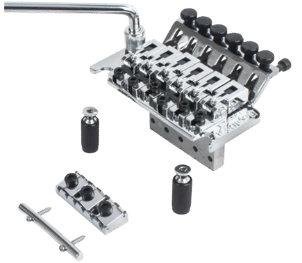
“Double-Locking” System
Floyd Rose Tremolo – Foolproof Double Locking Systems
Double-locking tremolo systems give you a foolproof way of keeping your guitar in tune, no matter how aggressively you use it.
However, this assumes that it has been set up correctly and that your strings are in good shape and properly stretched when new.
If you have a heavy hand with the whammy bar, then this is the ideal tremolo system for you.
Guitars that feature an “original” Floyd Rose tremolo system are usually on the more expensive side. On the other hand, double-locking “licensed” systems are more affordable but may be of lower quality.
This design turned out to be the gold standard among “whammy bar abusers.”
Kahler Guitar Tremolo Systems – Single Locking Alternative

Around the time that Floyd Rose double-locking systems made their appearance, Kahler introduced its tremolo system for guitars. Unfortunately, the Kahler tremolo wasn’t as popular, so it lost the “tremolo war.”
While the Floyd Rose system used a knife-edge design with fixed saddles, the Kahler system used a ball bearing and cam design with rolling saddles.
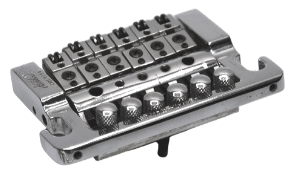
This design allowed it to function smoothly and keep the contact point between the string and saddle consistent, optimizing tone and harmonics.
Unlike the Floyd Rose system, which featured both a locking nut and bridge, the Kahler system had a locking nut but a non-locking bridge.
This made string changes quicker with the Kahler but at the expense of tuning stability. So again, as with the Floyd Rose system, proper setup is a must for proper function.
I have a Strat equipped with an after-market Kahler, and it works very well for the way I play, but I am more of a whammy bar wrangler than a whammy dive bomber.
Think Twice Before Upgrading Your Tremolo

If you have a Strat or similar whammy bar guitar that plays and sounds great, then you should think twice before upgrading the tremolo, especially if it involves making permanent modifications to the body.
You may not love the sound, no matter what adjustments you make.
You can always buy a double locking tremolo guitar for playing the “over-the-top” stuff.
You can be quite expressive with a standard tremolo bridge. If you don’t believe me, then check out what Jeff Beck can do with a standard 2-point Fender tremolo or what Yngwie Malmsteen does with a vintage-style Strat bridge.
Although it’s nice to have all the toys, an equipment upgrade is not a substitute for practicing harder to play better.
Also, remember, if you keep your guitar for 20 or 30 years, it will be a lot more valuable as it ages if it is all original.

Final Thoughts On Stratocaster Tremolo Setup
Not everyone needs a guitar with a whammy bar, but it can quickly become an addictive part of your playing once you try one out.
At the very least, they are fun to play with and can add a cool look to your guitar.
There are many different types of tremolos and a variety of ways to set them up, depending on your playing style.
Basic tremolo systems are more than adequate for guitarists who occasionally use a whammy bar to highlight a musical passage. However, staying in tune can be problematic if you are an aggressive player, and you may need a more sophisticated tremolo system.
Using the right combination of tuning machines, string trees, nut, and tremolo bridge is key to designing a system that works for your playing style.
You shouldn’t modify or upgrade your tremolo system unless it is clearly inadequate for your playing needs.
It can take quite a while to become proficient with using a whammy bar properly.
What To Read Next ➡ How Often Should You Setup Your Guitar: Key Facts Revealed!
Related Article ➡ Do You Need 24 Frets? – Are They Better Than 22 Fret Guitars

Tell Us What You Think
Please let me know what’s on your mind in the comment section or if I can help you with anything?
- Did you find this information helpful? Do you think it will help your guitar stay in tune?
- What are you currently doing or using to help keep your Strat or other guitar’s whammy bar in tune?
- Any tips and tricks to share and how are they helpful?
- What do you like best (or least) about the sound of your stock Strat tremolo?




OMG! What a wealth of information here! Thank you so much and I was just engrossed reading all the information. I am a bass and rhythm guitarist and don’t use tromolo much since I don’t do a lot of lead guitar playing. Now after reading your post, I am very much interested in trying this out. The variations that can be brought into the music with this seems very interesting. I would be doing some experimentation on this now. Thanks a lot for the wonderful post.
Hi, Augustine
Thank You for your comments!
I’m really thrilled that you enjoyed this article! There’s so much you can do with adding some whammy bar to music. Just listen to the masters that took this to the next level like Hendrix, Van Halen, Satriani, Vai, Johnson, and the list goes on.
The types of tremolo equipment available and adjustments on them are as unique as each individual player.
I hope you will come back to visit my site often. There’s lots of really cool info yet to come!
Frank
Hi Frank. Thank you for very interesting article. Im just stating my adventure with guitar and to be fair never thought too much about tremolo. I never used it, but looking on your post it gives great possibilities to get best from guitar. Looking forward to use your advices and recommendations in practice, and I hope it will improve my performance.
Hi, Cogito
Thank You for your comments!
What I recommend is that if you already have a tremolo guitar and the whammy bar is not attached, then pop it in so that you will begin to use it. If not, then think about getting a guitar with a whammy bar at some point. You don’t necessarily have to spend a lot of money to get a decent instrument.
When first starting out, it’s important to try to use the bar “musically.” Don’t just make strange noises with it. Instead, try to bend in and out of notes in the melody of a song or your guitar solo.
Check out Jeff Beck, who is an absolute master of the whammy bar, and notice how he uses it in the melody of the song and also adds bits of “flash” here and there to “wow” the audience.
Frank
Great post…. Mike
Hi, Mike
I really appreciate that!
Setting up a tremolo can be a little tricky, especially if it “floats” and you use it aggressively. Let me know if you have any questions or anything I can do to help!
Frank
Floyd rose robs tone but are fun as hell. Hardtail strat and a seperate floyd guitar is the answer for me. Then again i have 17 guitars.Its a obsession lol. And want more and more love them all!
Hi, Lawrence
Thank You for your comments!
I agree. Actually, any tremolo set up with a floating bridge can steal your tone to some extent. I have a few hardtail Strats but I prefer the tone you get from a Strat with a blocked whammy bar, the way Eric Clapton does it. The springs in the tremolo cavity acoustically resonate to give you a more three-dimensional sound.
I have two Eric Clapton Signature Strats, a first-generation Strat with Gold Lace Sensor pickups, and a Custom Shop model with vintage noiseless pickups. They both come set up with the tremolo block frozen in the down position with a piece of wood.
Believe it or not, I have over 60 guitars, between the ones I bought and built over the years. It is an obsession, but a great one! ??
Frank